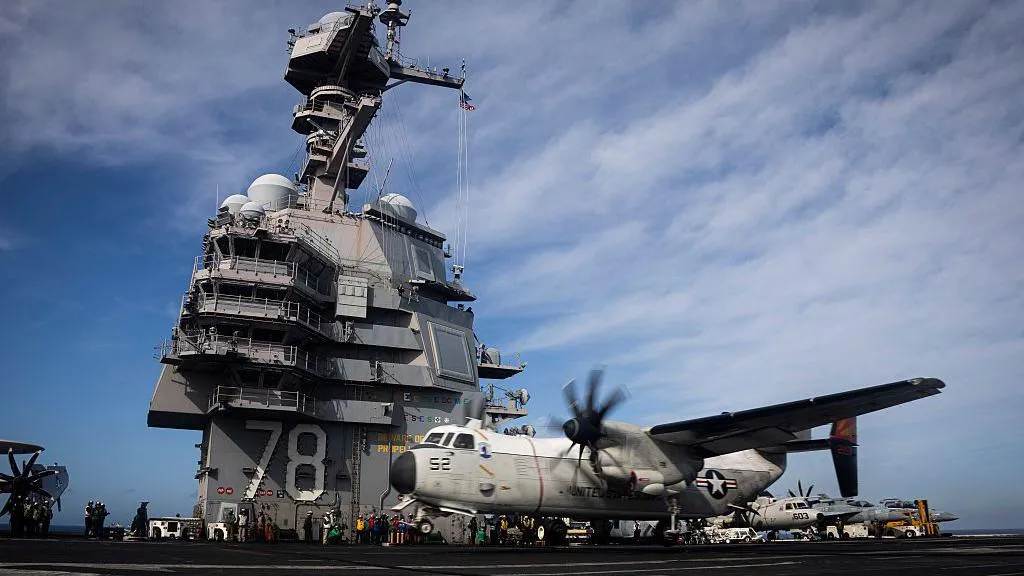U.S. Expands Military Presence Near the Caribbean with USS Gerald R. Ford
The U.S. Navy has deployed one of its most powerful strike forces, centered around the USS Gerald R. Ford, to the Caribbean and Latin American waters. This deployment highlights the presence of the USS Gerald R. Ford strike group in Latin America. The move comes as part of Washington’s broader mission to combat narcotics trafficking and counter regional instability. The carrier, known as the world’s largest warship, leads a group of guided-missile destroyers, support vessels, and aircraft. Together, they form a combined force of over 4,000 sailors.
The deployment was directed by the President last month. It falls under the jurisdiction of the U.S. Southern Command, which oversees military operations across Latin America and the Caribbean. This strategic maneuver enhances surveillance and operational capabilities. It is aimed at dismantling organized criminal networks and intercepting illicit maritime traffic. According to the Navy’s statement, the mission’s primary goal is to “detect, monitor, and disrupt illicit actors” operating within the region’s maritime corridors.
The arrival of the Gerald R. Ford group signals the largest U.S. naval presence in Latin America in decades. It joins existing assets such as submarines and military aircraft stationed in Puerto Rico. The fleet also supports coordinated missions in partnership with regional allies. This reinforces maritime security across the Caribbean and eastern Pacific. For more insight into U.S. Southern Command operations, visit the U.S. Southern Command official page.
Anti-Drug Strikes Intensify Across the Caribbean and Eastern Pacific
In recent months, the U.S. has conducted at least 19 targeted strikes against vessels suspected of smuggling narcotics across the Caribbean Sea and the Pacific Ocean. These operations have reportedly resulted in over 76 fatalities. They reflect an escalating military campaign aimed at curbing the drug flow that fuels violence and corruption across Latin America.
The Pentagon insists the operations are necessary to protect American communities and deter transnational criminal organizations. However, the strikes have sparked tensions with Venezuela and Colombia. Their leaders accuse Washington of overreach and violations of sovereignty. The Venezuelan government, led by Nicolás Maduro, has denounced the U.S. deployment as an attempt to “fabricate a crisis.” They argue it is meant to destabilize the socialist administration in Caracas.
Amid these accusations, the U.S. maintains that its actions are grounded in international law. They are justified under regional security frameworks. Analysts note that the naval buildup mirrors Cold War-era strategies. In those times, the projection of maritime power was central to American influence in Latin America. To better understand the ongoing U.S. anti-drug strategy, readers can review policy documents and updates from the U.S. Department of Defense detailing regional missions and cooperative initiatives.
Despite rising political frictions, Washington has reiterated its commitment to a stable and drug-free hemisphere. It emphasizes collaboration with nations aligned with the Inter-American Drug Abuse Control Commission under the Organization of American States. Information on these multilateral programs can be found through the OAS official website.
Regional Tensions and the Strategic Implications of U.S. Naval Power
The deployment of the USS Gerald R. Ford to Latin America has generated intense geopolitical speculation. Beyond its stated purpose of disrupting narcotics routes, the move symbolizes a broader assertion of U.S. strategic dominance in the Western Hemisphere. The carrier’s presence projects power and deterrence. It signals that Washington remains deeply engaged in shaping regional security dynamics amid growing concerns over external influences and authoritarian regimes.
Military experts highlight that the Gerald R. Ford’s advanced technology—featuring electromagnetic catapults, enhanced radar systems, and next-generation aircraft—positions it as a symbol of modern American naval supremacy. Its presence near Venezuelan and Caribbean waters underscores Washington’s readiness to defend maritime trade routes. It upholds freedom of navigation across critical waterways.
Observers point out that Latin America has become increasingly contested space in global geopolitics. China and Russia are expanding their diplomatic and commercial footprints. The U.S. response through naval deployments seeks to reaffirm its longstanding role as the region’s primary security guarantor. For an overview of U.S. naval assets and regional deployments, visit the U.S. Navy’s fleet information page.
As the USS Gerald R. Ford continues operations near Latin America, it embodies both a tactical initiative against transnational crime and a strategic message to global rivals. The deployment reveals Washington’s intent to maintain influence. This is over a region where maritime control, economic stability, and political sovereignty remain deeply interconnected.





